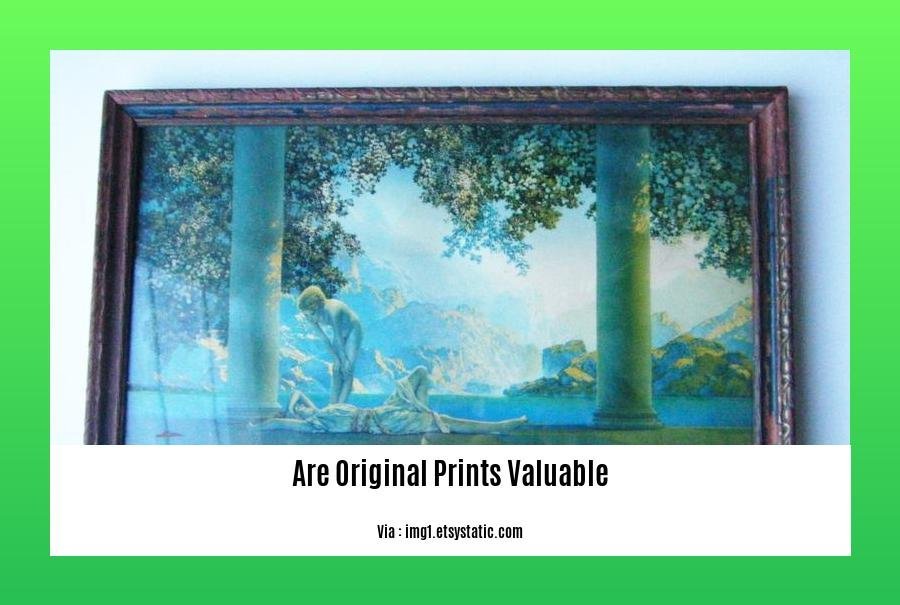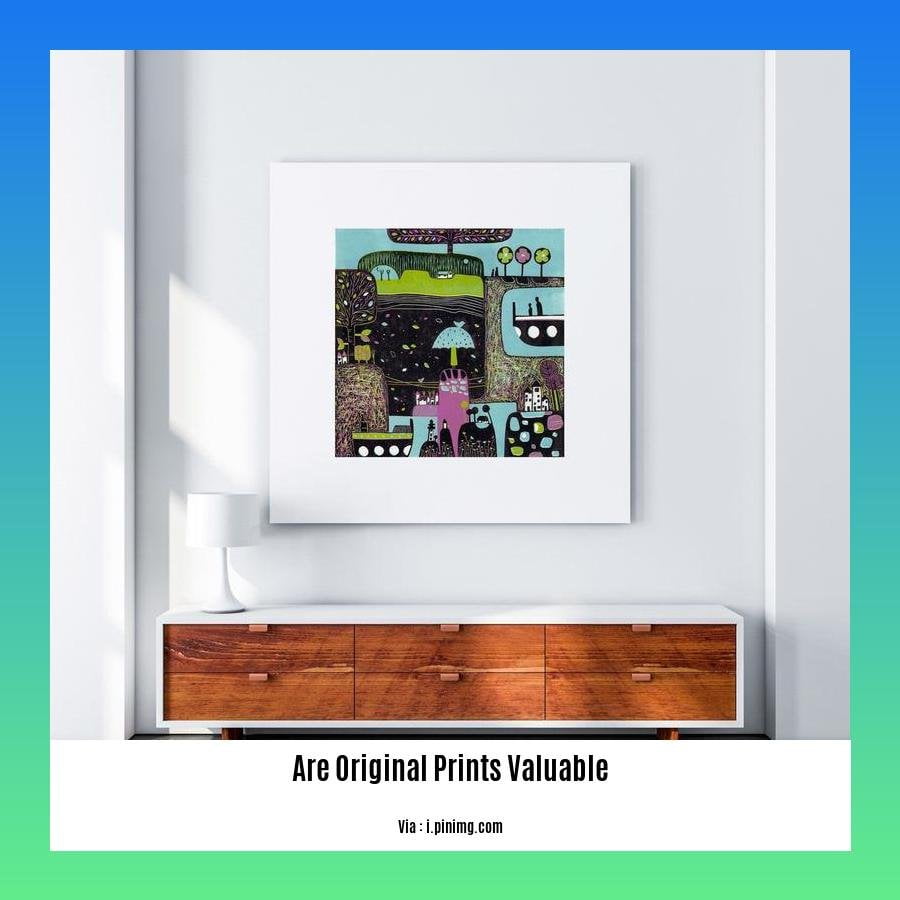Uncover the world of original prints and their captivating allure in [- Are Original Prints Valuable: A Guide for Art Enthusiasts]. Delve into the realm of fine art, where skilled hands and creative minds birth extraordinary pieces that transcend time. Discover the factors that determine the worth of an original print, from its rarity and condition to the artist’s reputation and the printing technique employed. Embark on a journey of appreciation for these unique artworks and learn how to discern their true value.
Key Takeaways:
Not all art prints are valuable, but some can be valuable investments.
Factors that determine the value of an art print include scarcity, availability, popularity, quality, and price.
Limited edition prints with lower numbers usually have a higher value.
Original prints signed by the artist, especially those with a limited number (usually less than 100), are more valuable.
Older methods used in creating prints, such as Woodcut, engraving, etching, and lithography, are often more valuable compared to digital and screen prints.
Artist proofs, which have unique characteristics similar to original artworks, are often worth more than limited edition signed prints.
Are Original Prints Valuable?

Limited Edition Prints Hold Value:
- Scarcity and Availability: Prints with lower editions are rarer, increasing their value.
- Popularity: Prints of highly sought-after artists often retain value over time.
- Quality and Price: Prints using superior materials and processes have increased value.
Signed and Numbered Prints:
- Signature Matters: Prints signed by established artists are worth more.
- Limited Numbers: Prints with lower numbers (typically under 100) command higher value.
Traditional Printing Methods:
- Older Methods: Prints made using traditional methods like woodcut, engraving, etching, and lithography are more valuable than digital and screen prints.
- Unique Characteristics: Traditional methods often create unique variations, making each print slightly different and valuable.
Appreciation Over Time:
- Aging and Rarity: Original prints can appreciate in value as they age and become rarer.
- Historical Significance: Prints with historical significance can garner considerable value over time.
Artist Proofs and Value:
- Unique Characteristics: Artist proofs often have unique characteristics similar to original artworks, making them more valuable.
- Limited Availability: Artist proofs are typically produced in small quantities, increasing their value.
Assessment of Prints:
- Condition: Prints in good condition, with no damage or fading, are more valuable.
- Documentation: Prints with documentation, such as certificates of authenticity, can command higher prices.
Conclusion:
Are Original Prints Valuable? Yes, they can hold significant value based on various factors like scarcity, condition, and artist reputation. However, not all prints are valuable investments. Do your research, consider the factors mentioned, and consult experts to make informed decisions. Original prints can be a rewarding addition to any art collection, offering both aesthetic pleasure and potential financial rewards.
Dive into the captivating history of printmaking prints, tracing the evolution of this fascinating art form from its ancient origins to contemporary practices.
Embark on a journey to uncover the intriguing origins of printmaking by exploring When Did Printmaking Originate, and learn about the pivotal moments that shaped this art form.
Immerse yourself in the world of art collecting by delving into the fascinating topic Are Prints Of Paintings Worth Anything, gaining insight into the value and significance of print reproductions.
Delve into the rich tapestry of History Of Printmaking In Art, discovering the pivotal role this art form has played in shaping artistic expression throughout history.
Explore the profound significance of printmaking in society by examining Why Is Printmaking Important In Our Society, revealing its impact on cultural identity, historical documentation, and artistic appreciation.
Benefits of Owning an Original Print

Greetings, art enthusiasts! Today, let’s explore the captivating world of original prints and delve into the unique benefits that owning one can bring to your life. From accessible originals to the diversity of techniques, let’s uncover why prints are true gems in the art world.
Advantages of Owning an Original Print
- Accessible Originals:
- Original prints are more affordable than unique artworks, allowing you to own an authentic piece of art without breaking the bank.
- Availability is wider, which means you can find prints that resonate with your taste and space.
Supporting the artist: Purchasing an original print directly contributes to the livelihood of talented artists.
Variety of Techniques:
- Original prints offer a vast array of techniques, each with its own artistic expression.
- Enhances appreciation: Exploring different printmaking methods enriches your understanding and appreciation of the artwork.
Different interpretations: The unique nature of printmaking allows for multiple interpretations of the same piece, adding depth to your art experience.
Easy Shipping:
- Prints are typically smaller and lighter than unique artworks, making them easier to ship.
- Reduced costs: Shipping prints is more economical, saving you money on transportation.
Less risk: Smaller size and lightweight nature reduce the risk of damage during transit, ensuring your print arrives safely.
More Market Data:
- Prints have a well-established market with ample data available.
- Informed decisions: Access to market data helps you make educated choices, ensuring you get a fair value for your investment.
- Potential value appreciation: Over time, the value of prints can appreciate, making them a potentially lucrative asset.
Key Takeaways:
- Original prints offer affordability, wider availability, and the opportunity to support artists.
- The variety of printmaking techniques adds depth and richness to your art appreciation.
- Shipping prints is easier, more economical, and reduces the risk of damage.
- The established market for prints provides valuable data for informed decisions and potential value appreciation.
I hope this discussion has shed light on the benefits of owning an original print. Whether you’re a seasoned collector or an art enthusiast, these advantages make prints an appealing choice for enhancing your living space, supporting artists, and immersing yourself in the world of art.
Sources:
- The Advantages of Buying Prints over Unique Artworks
- You Should Be Buying Art Prints and Don’t Let Anyone Tell You Otherwise
Investment Potential of Original Prints
Let’s dive into the world of original prints and explore their investment potential. First off, understand that prints are not just mass-produced posters. They’re artworks, meticulously crafted by artists using various printmaking techniques, each with its own unique charm. So, what makes them a worthwhile investment?
- Limited Editions:
- Original prints often come in limited editions, making them exclusive.
Scarcity drives up value, especially if the artist’s popularity grows over time.
Appreciation Over Time:
- As the artist’s reputation and demand for their work increase, the value of their prints tends to appreciate.
Patience is key; prints may take time to gain significant value.
Diversifying Your Portfolio:
- Consider prints as a way to diversify your portfolio and spread your risk.
Art, in general, is less correlated with traditional investments like stocks and bonds.
Relatively Accessible:
- Compared to unique artworks, original prints are often more affordable.
- This makes them a great starting point for building an art collection.
Key Takeaways:
Limited editions: Original prints are often produced in limited quantities, making them exclusive and increasing their value.
Appreciation over time: As demand for the artist’s work increases, the value of their prints tends to appreciate, providing a potential return on investment over time.
Diversification of portfolio: Original prints offer an opportunity to diversify an investment portfolio, spreading risk across different asset classes.
Accessibility: Compared to unique artworks, original prints are often more affordable, making them a good starting point for art collectors.
Historical significance: Prints with historical or cultural significance may have increased value due to their rarity and association with important events or movements.
Sources:
Grove Gallery
Invaluable
Tips to preserve and maintain the value of original prints
Hello, art enthusiasts! I’m here to share some crucial tips on preserving and maintaining the value of your precious original prints.
Key Takeaways:
Protect them from light and moisture: Original prints are delicate and can easily fade or deteriorate when exposed to sunlight or excessive moisture. Keep them in a cool, dry place, away from direct light sources and humid environments. An acid-free print storage folder or portfolio is also a great way to shield your prints from dirt and dust.
Handle them with care: Prints are susceptible to damage from fingerprints, smudges, and scratches. Use clean cotton gloves or clean hands whenever you handle a print.
Avoid framing prints directly: Direct contact between the print and the glass can cause moisture buildup, leading to damage. Use an acid-free mat or backing board between them to create a buffer.
Periodically inspect your prints: Regularly inspect your prints for signs of damage or deterioration, such as fading, discoloration, or foxing. Early detection can help prevent further damage and maintain the print’s value.
Invest in professional conservation: If you notice any signs of damage or deterioration, consult a professional conservator. They have the expertise and tools to properly clean, repair, and restore your prints, preserving their value and beauty for years to come.
Store prints in a temperature-controlled environment: Ideal storage conditions for original prints involve stable temperature and humidity levels. Keeping them in a cool, dry place will help prevent warping, buckling, or other damage caused by extreme temperatures or humidity.
Keep your prints away from harmful chemicals: Chemicals, such as solvents and cleaning agents, can damage or discolor prints. Store your prints away from areas where these chemicals are used or stored.
Use archival-quality materials: When framing or storing your prints, use archival-quality materials specifically designed for preserving artworks. These materials are acid-free and will not cause damage over time.
Document your prints: Keep detailed records of your prints, including their title, artist, edition number, and any relevant provenance information. This documentation will be invaluable if you ever need to insure, sell, or exhibit your prints.
By following these valuable tips, you can protect your original prints, preserve their beauty and value, and ensure they remain a treasured part of your art collection for years to come.
Remember, the preservation of original prints is not just about maintaining their monetary value; it’s about preserving a piece of art history and ensuring that future generations can appreciate and enjoy these cultural treasures.
Sources:
– Caring for Your Art Prints: A Guide for Collectors
– How to Preserve and Protect Artwork: Storage and Handling
FAQ
Q1: How can I determine the value of an original print?
A1: The value of an original print is influenced by various factors such as its scarcity, availability, popularity, quality, and price. Limited edition prints with lower numbers, original prints signed by the artist, and those created using older printing methods like Woodcut, engraving, etching, and lithography tend to have higher value.
Q2: Are all original prints valuable?
A2: Not all original prints are valuable. The value of an original print depends on its scarcity, popularity, condition, and other factors. Some original prints may have limited value, while others, particularly those created by renowned artists or using rare or specialized printing techniques, can be highly valuable.
Q3: What factors contribute to the value of an original print?
A3: The factors that contribute to the value of an original print include its scarcity (limited edition prints with lower numbers are generally more valuable), availability (prints that are easily accessible may have lower value), popularity (prints by well-known artists tend to have higher value), quality (prints in good condition and those created using high-quality materials are more valuable), and price (the original price of the print can influence its perceived value).
Q4: How can I distinguish between an original print and a reproduction?
A4: Original prints typically have unique characteristics that distinguish them from reproductions. These characteristics may include the artist’s signature, a limited edition number, the use of specific printing techniques, or the presence of a certificate of authenticity.
Q5: Where can I find more information about the value of original prints?
A5: There are several resources available to learn more about the value of original prints. Art galleries, auction houses, and reputable online platforms often provide information on the value of specific prints. Additionally, art experts, appraisers, and art collectors can offer valuable insights into the factors that influence the value of original prints.
- China II Review: Delicious Food & Speedy Service - April 17, 2025
- Understand Virginia’s Flag: History & Debate - April 17, 2025
- Explore Long Island’s Map: Unique Regions & Insights - April 17, 2025
















